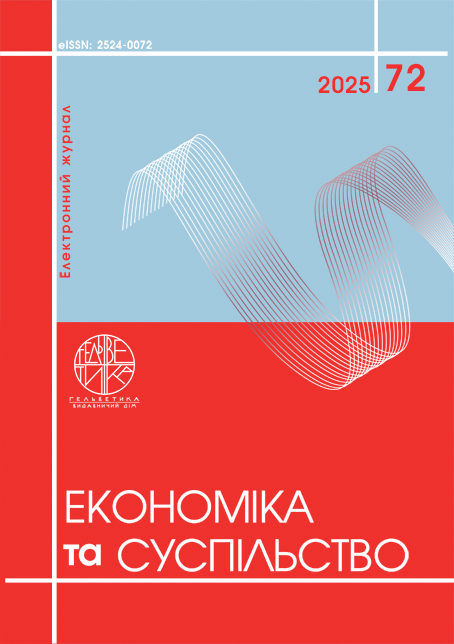STAGES OF DEVELOPMENT OF STAFF DEMOTIVATION AND ITS IMPACT ON ORGANIZATIONAL EFFECTIVENESS IN THE MANAGERIAL CONTEXT
Abstract
The purpose of the article is to analyze the stages of development of staff demotivation and its toxic risks, and to study their impact on the efficiency of management processes. The relevance of the topic is due to constant changes in modern management, where demotivation is a significant factor affecting the efficiency of organizations. Identification of toxic risks associated with demotivation and their elimination is important for maintaining stability and productivity in organizations. The research methods include analysis of scientific papers, study of theoretical models of motivation and demotivation, as well as empirical research through interviews and questionnaires with employees of organizations in various sectors. The applied methods of content analysis allow us to identify the main trends and factors influencing demotivation. It is noted that staff demotivation in the process of its development goes through several stages, ranging from dissatisfaction and apathy to a sense of hopelessness. Studying the stages of demotivation allows you to identify critical moments when intervention is needed to prevent further deterioration. Particularly dangerous is the toxic effect, which can have long-term consequences for the organization, in particular, in the form of reduced productivity and even high staff turnover. It has been shown that demotivation not only reduces employee engagement but also leads to a deterioration in teamwork and the overall efficiency of organizational processes. The main differences between demotivation and toxic demotivation are considered separately, where the latter is characterized not only by a decrease in engagement but also by the emergence of negative emotional reactions, such as aggression, cynicism, or loss of trust in the organization. The practical value of the article lies in identifying the stages of demotivation development, analyzing the main differences between motivation and demotivation, and assessing the impact of demotivation on the organizational activities of an enterprise. Identifying critical moments when demotivation can lead to serious consequences allows managers to respond to negative trends in a timely manner. The results of the study can become the basis for developing strategies to improve the organizational climate and increase employee engagement.
References
Захарчин Г.М., Любомудрова Н.П. Методичні засади формування систем мотивації праці в сучасному менеджменті. Глобальні та національні проблеми економіки. 2015. Вип. 8. С. 393–397. URL: http://global-national.in.ua/issue-8-2015. (дата звернення: 28.02.2025).
Нетудихата К. Л., Погромський В. О., Стройнецький В. М. Діагностика стану розвитку мотиваційних механізмів в системі кадрового менеджменту. Ефективна економіка. 2021. № 6. DOI: https://doi.org/10.32702/2307-2105-2021.6.91 (дата звернення: 28.02.2025).
Прохоровська, С. Мотивація персоналу підприємств в умовах сучасних викликів. Трансформаційна економіка. 2023. № 2 (02), C. 45-48. URL: https://doi.org/10.32782/2786-8141/2023-2-8 (дата звернення: 1.03.2025).
Мирошниченко Ю.В., Головатюк А.І. Проблеми демотивації персоналу та шляхи її подолання. Молодий вчений. 2015. №. 12(2). С. 81–84.
Іваницька С.Б., Галайда Т.О, Дяченко Ю.О. Проблеми виявлення та подолання негативного впливу чинників демотивації персоналу на результативність праці. Економіка і суспільство. 2018. Випуск № 19. С. 409- 416.
Татомир І.Л. Вплив демотиваційних факторів на формування поведінки працівника в умовах інформаційного суспільства. Економіка та держава. 2008. № 11. С. 37–39. URL: http://nbuv.gov.ua/UJRN/ecde_2008_11_12 (дата звернення: 1.03.2025).
Смірнова К., Чабанюк А. Причини, наслідки та способи подолання демотивації персоналу в сучасних умовах. Економіка та суспільство. 2021. № 32. URL: https://doi.org/10.32782/2524-0072/2021-32-30 (дата звернення: 2.03.2025).
Пересипкiна Н. Мотивація персоналу: чому негативні стимули не працюють. Кадровик України. 2016. № 7. URL: https://budni.robota.ua/hr/motivatsiya-personalu-chomu-negativni-stimuli-ne-pratsyuyut (дата звернення: 1.03.2025).
Веретюк В. Демотивація: що робити? URL: https://stud-point.com/blog/self-development-and-motivation/demotyvatsiia-shcho-robyty/ (дата звернення: 1.03.2025).
Овчаренко М. Демотивація: шукаємо причини. Молоко і ферма. 2021. № 5 (66). URL: http://milkua.info/uk/post/demotivacia-sukaemo-pricini (дата звернення: 2.03.2025).
Мотивація і демотивація персоналу: як працює метод “кнута і пряника”? URL: https://lov.qame.info/articles/kouching/motivacziya-i-demotivacziya-personala-kak-rabotaet-metod-knuta-i-pryanika/ (дата звернення: 2.03.2025).
Zakharchyn G.M., Lyubomudrova N.P. (2015) Metodychni zasady formuvannia system motyvatsii pratsi v suchasnomu menedzhmenti [Methodological principles of forming labor motivation systems in modern management]. Global and national problems of the economy. Vol. 8. pp. 393–397. Available at: http://global-national.in.ua/issue-8-2015. (accessed 28 February 2025).
Netudikhata K. L., Pogromsky V. O., Stroynetsky V. M. (2021) Diahnostyka stanu rozvytku motyvatsiinykh mekhanizmiv v systemi kadrovoho menedzhmentu [Diagnostics of the state of development of motivational mechanisms in the personnel management system]. Effective economy. Vol. 6. Available at: https://doi.org/10.32702/2307-2105-2021.6.91 (accessed 28 February 2025).
Prokhorovska S. (2023) Motyvatsiia personalu pidpryiemstv v umovakh suchasnykh vyklykiv [Motivation of enterprise personnel in the context of modern challenges]. Transformational economics. no. 2 (02), pp. 45-48. Available at: https://doi.org/10.32782/2786-8141/2023-2-8 (accessed 1 March 2025).
Myroshnychenko Yu.V., Holovatyuk A.I. (2015) Problemy demotyvatsii personalu ta shliakhy yii podolannia [Problems of personnel demotivation and ways to overcome it]. Young scientist. no. 12(2). pp. 81–84.
Ivanytska S.B., Galayda T.O., Dyachenko Y.O. (2018) Problemy vyiavlennia ta podolannia nehatyvnoho vplyvu chynnykiv demotyvatsii personalu na rezultatyvnist pratsi [Problems of identifying and overcoming the negative impact of personnel demotivation factors on labor productivity]. Economy and Society. no. 19. pp. 409-416.
Tatomyr I.L. (2008) Vplyv demotyvatsiinykh faktoriv na formuvannia povedinky pratsivnyka v umovakh informatsiinoho suspilstva [The influence of demotivational factors on the formation of employee behavior in the information society]. Economy and State. no. 11. pp. 37–39. Available at: http://nbuv.gov.ua/UJRN/ecde_2008_11_12 (accessed 1 March 2025).
Smirnova K., Chabaniuk A. (2021) Prychyny, naslidky ta sposoby podolannia demotyvatsii personalu v suchasnykh umovakh [Causes, consequences and ways to overcome personnel demotivation in modern conditions]. Economy and Society. no. 32. Available at: https://doi.org/10.32782/2524-0072/2021-32-30 (accessed 2 March 2025).
Peresypkina N. (2016) Motyvatsiia personalu: chomu nehatyvni stymuly ne pratsiuiut [Personnel motivation: why negative incentives do not work]. Human Resources of Ukraine. no. 7. Available at: https://budni.robota.ua/hr/motivatsiya-personalu-chomu-negativni-stimuli-ne-pratsyuyut (accessed 1 March 2025).
Veretyuk V. (2023) Demotyvatsiia: shcho robyty? [Demotivation: what to do?]. Available at: https://stud-point.com/blog/self-development-and-motivation/demotyvatsiia-shcho-robyty/ (accessed 1 March 2025).
Ovcharenko M. (2021) Demotyvatsiia: shukaiemo prychyny [Demotivation: looking for reasons]. Milk and Farm. no. 5 (66). Available at: http://milkua.info/uk/post/demotivacia-sukaemo-pricini (accessed 2 March 2025).
Motyvatsiia i demotyvatsiia personalu: yak pratsiuie metod “knuta i prianyka”? [Motivation and demotivation of personnel: how does the “carrot and stick” method work?] Available at: https://lov.qame.info/articles/kouching/motivacziya-i-demotivacziya-personala-kak-rabotaet-metod-knuta-i-pryanika/ (accessed 2 March 2025).

This work is licensed under a Creative Commons Attribution 4.0 International License.


